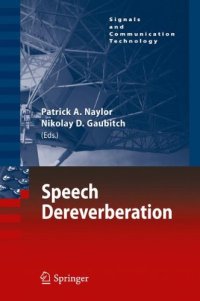
Ebook: Speech Dereverberation
- Genre: Technique // Communication
- Tags: Signal Image and Speech Processing, Data Structures Cryptology and Information Theory, Computational Intelligence
- Series: Signals and Commmunication Technology
- Year: 2010
- Publisher: Springer-Verlag London
- Edition: 1
- Language: English
- pdf
Speech dereverberation is a signal processing technique of key importance for successful hands-free speech acquisition in applications of telecommunications and automatic speech recognition. Over the last few years, speech dereverberation has become a hot research topic driven by consumer demand, the availability of terminals based on Skype™ which encourage hands-free operation and the development of promising signal processing algorithms. Speech Dereverberation gathers together an overview, a mathematical formulation of the problem and the state-of-the-art solutions for dereverberation.
Speech Dereverberation presents the most important current approaches to the problem of reverberation. It begins by providing a focused and digestible review of the relevant topics in room acoustics and also describes key performance measures for dereverberation. The algorithms are then explained together with relevant mathematical analysis and supporting examples that enable the reader to see the relative strengths and weaknesses of the various techniques, as well as giving a clear understanding of the open questions still to be addressed in this topic. Techniques rooted in speech enhancement are included, in addition to a substantial treatment of multichannel blind acoustic system identification and inversion. The TRINICON framework is shown in the context of dereverberation to be a powerful generalization of the signal processing for a important range of analysis and enhancement techniques.
Speech Dereverberation offers the reader an overview of the subject area, as well as an in-depth text on the advanced signal processing involved. The book benefits the reader by providing such a wealth of information in one place, defines the current state of the art and, lastly, encourages further work on this topic by offering open research questions to exercise the curiosity of the reader. It is suitable for students at masters and doctoral level, as well as established researchers.